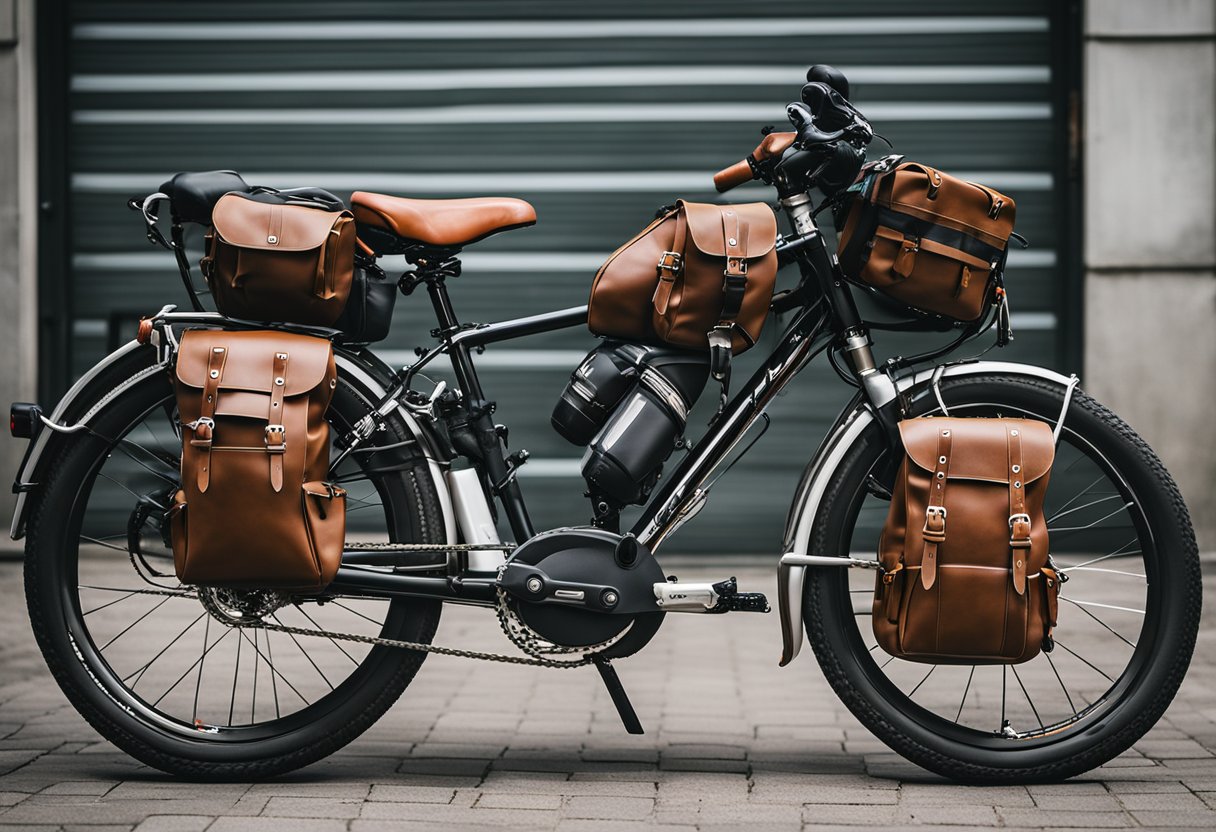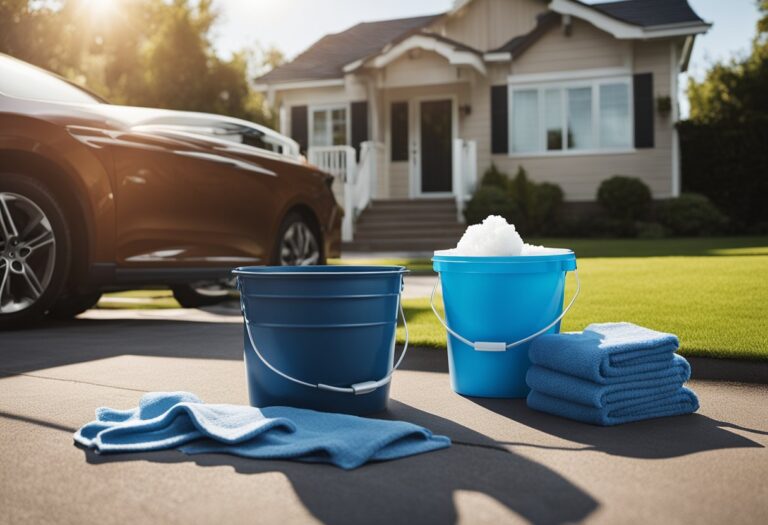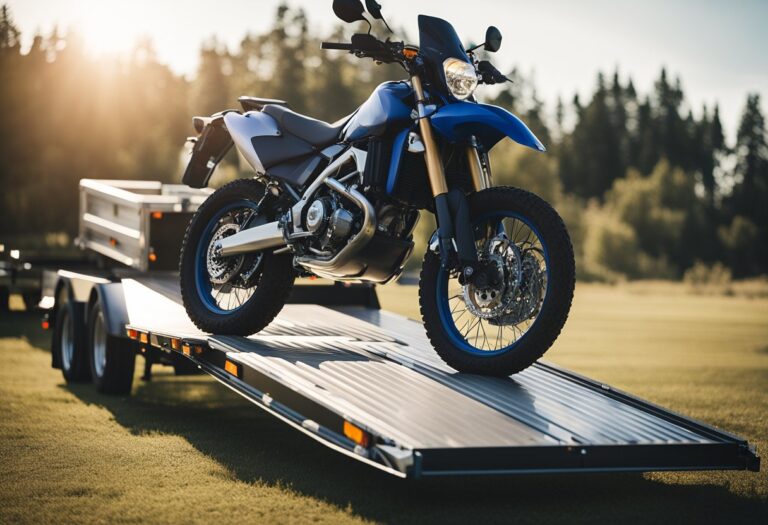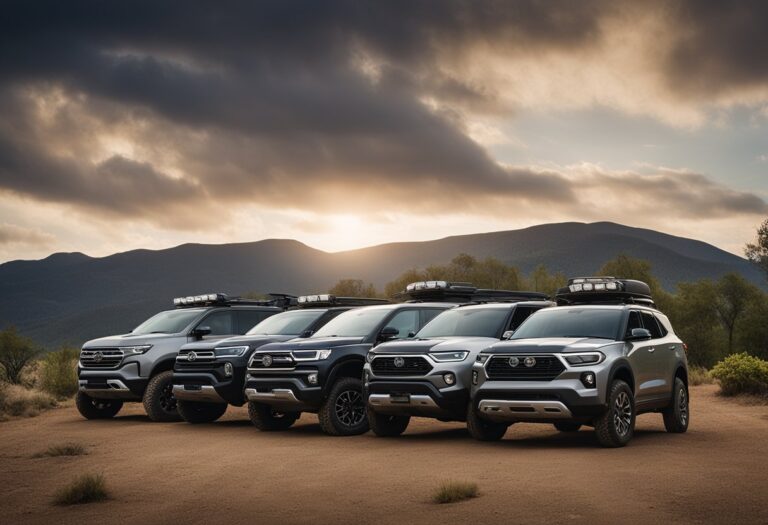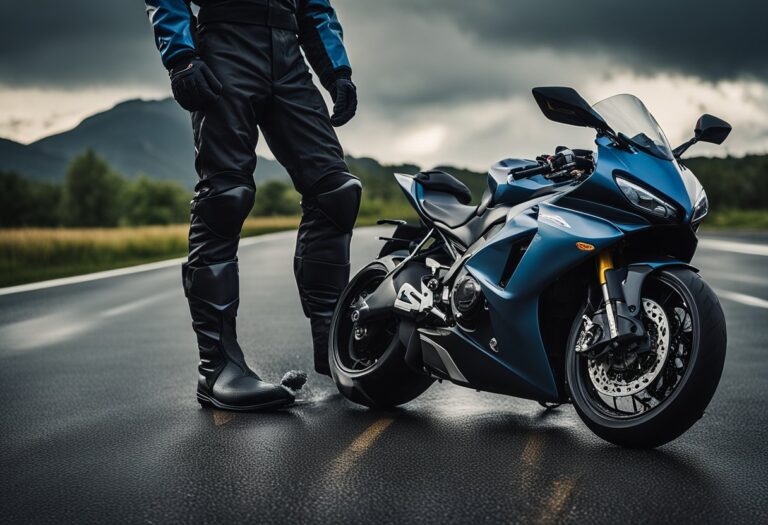Saddlebag Mounting Options for Touring Bikes: A Comprehensive Guide
Saddlebags are an essential accessory for touring bikes, as they provide ample storage space for long-distance travel. However, choosing the right saddlebag mounting option can be a daunting task, as there are various types of mounting systems available in the market. Each mounting system has its own set of advantages and disadvantages, and selecting the wrong one can lead to safety hazards and damage to the bike.

This article will provide a comprehensive guide to saddlebag mounting options for touring bikes. It will cover the different types of saddlebags available in the market, the various mounting systems, and the material considerations that need to be taken into account while selecting a saddlebag. Additionally, the article will also discuss the compatibility of saddlebags with different bike models, installation tips, weight distribution, security features, maintenance and care, and customization options.
Key Takeaways
- Understanding the different types of saddlebags and mounting systems is crucial for selecting the right saddlebag for your touring bike.
- Material considerations such as durability, weather resistance, and weight should be taken into account while selecting a saddlebag.
- Proper installation, weight distribution, and security features are essential for ensuring a safe and comfortable ride with saddlebags.
Types of Saddlebags

Panniers
Panniers are the most common type of saddlebag used by touring cyclists. They are designed to attach to the sides of the rear rack and come in various sizes, shapes, and materials. Panniers are great for carrying a lot of gear and distributing the weight evenly on the bike. They can be waterproof or water-resistant, and some models have additional pockets and compartments for organizing smaller items.
Seat Packs
Seat packs are a popular choice for bikepackers and minimalist tourers. They attach to the seatpost and saddle rails and sit behind the rider. Seat packs come in different sizes, ranging from small to large, and can hold clothing, sleeping bags, and other lightweight gear. They are usually made of waterproof materials and are easy to install and remove.
Handlebar Bags
Handlebar bags attach to the handlebars and stem and are ideal for carrying small, frequently accessed items such as snacks, electronics, and maps. They come in various shapes and sizes and can be made of waterproof or water-resistant materials. Handlebar bags can be used in combination with other types of saddlebags to increase storage capacity.
Frame Bags
Frame bags are designed to fit inside the bike frame triangle and are great for carrying heavy items such as tools, spare parts, and water bottles. They come in different sizes and shapes and can be made of waterproof or water-resistant materials. Frame bags are a good option for cyclists who want to keep the weight low and centered on the bike.
In conclusion, choosing the right type of saddlebag is essential for a successful touring experience. Panniers, seat packs, handlebar bags, and frame bags each have their unique advantages and disadvantages, and cyclists should consider their specific needs and preferences when making a choice.
Mounting Systems

Touring bikes require sturdy and reliable saddlebag mounting systems to carry the necessary gear for long-distance trips. There are three main types of mounting systems available for touring bikes: rack-mounted systems, strap-mounted systems, and clip-mounted systems.
Rack-Mounted Systems
Rack-mounted systems are the most popular choice for touring bikes. They are mounted on the rear rack of the bike, providing a stable and secure platform for the saddlebags. These systems are easy to install and remove, making them ideal for riders who frequently switch between different types of bags.
Rack-mounted systems also offer a high weight capacity, allowing riders to carry heavy loads without worrying about the bags coming loose or shifting during the ride. However, they do require a rear rack to be installed on the bike, which can add extra weight and cost.
Strap-Mounted Systems
Strap-mounted systems are another popular choice for touring bikes. They are attached to the bike using straps, which wrap around the seat post and the rear of the bike frame. These systems are lightweight and easy to install, making them ideal for riders who want a simple and affordable option.
Strap-mounted systems also offer good stability and support for the bags, although they may not be as secure as rack-mounted systems. They may also have a lower weight capacity, which can limit the amount of gear that can be carried.
Clip-Mounted Systems
Clip-mounted systems are the least common type of mounting system for touring bikes. They are attached to the bike using clips, which attach to the seat post and the rear of the bike frame. These systems are lightweight and easy to install, making them ideal for riders who want a simple and affordable option.
Clip-mounted systems offer good stability and support for the bags, although they may not be as secure as rack-mounted systems. They may also have a lower weight capacity, which can limit the amount of gear that can be carried. However, they do not require a rear rack to be installed on the bike, which can save weight and cost.
Material Considerations

Waterproof Materials
When choosing saddlebag mounting options for touring bikes, it is important to consider the materials used in their construction. One key factor to consider is waterproofing. Riders who frequently ride in wet conditions or in areas with high humidity should consider saddlebags made from waterproof materials to protect their belongings from water damage.
Some popular waterproof materials used in saddlebag construction include PVC-coated nylon, vinyl, and waterproof zippers. PVC-coated nylon and vinyl are both durable and resistant to water, making them ideal for long-term use. Waterproof zippers are also a great option for keeping water out of the saddlebag compartments.
Durability Factors
Another important consideration when choosing saddlebag mounting options for touring bikes is durability. Saddlebags that are not made from durable materials can easily get damaged or wear out quickly, leaving riders with the need to replace them frequently.
To ensure durability, riders should look for saddlebags made from materials such as heavy-duty nylon or leather. These materials are both strong and resistant to wear and tear. Additionally, saddlebags with reinforced stitching and heavy-duty zippers are less likely to fail or break under heavy use.
In summary, when choosing saddlebag mounting options for touring bikes, riders should consider waterproof materials and durability factors. By choosing saddlebags made from high-quality materials, riders can ensure their belongings are protected and their saddlebags will last for many miles of riding.
Compatibility with Bike Models

When it comes to saddlebag mounting options for touring bikes, compatibility with the bike model is an important consideration. Not all mounting options work with all types of bikes, so it’s essential to choose a system that is compatible with the specific make and model of your touring bike.
One of the most common mounting options is the throw-over system, which is compatible with most touring bikes. This system consists of two saddlebags that are connected by a strap that goes over the seat. The bags are then secured to the bike using straps that attach to the frame or fender. This system is easy to install and remove, making it a popular choice among touring riders.
Another mounting option is the hard mount system, which is typically designed for specific bike models. This system involves mounting brackets that are bolted to the bike’s frame, providing a secure and stable attachment for the saddlebags. Hard mount systems are more durable and secure than throw-over systems, but they can be more difficult to install and remove.
Some touring bikes come with built-in saddlebag mounting options, such as racks or brackets. These options are usually designed to work specifically with the bike model and provide a secure and stable attachment for the saddlebags. If your bike has built-in mounting options, it’s important to choose saddlebags that are compatible with those options.
In summary, when choosing a saddlebag mounting option for your touring bike, it’s essential to consider compatibility with the bike model. Throw-over systems are generally compatible with most touring bikes, while hard mount systems are typically designed for specific bike models. If your bike has built-in mounting options, it’s important to choose saddlebags that are compatible with those options for a secure and stable attachment.
Installation Tips

When installing saddlebags on a touring bike, there are a few tips to keep in mind to ensure a secure and stable fit.
Firstly, it is important to check the weight capacity of the mounting system and make sure that the saddlebags do not exceed this limit. Overloading the mounting system can cause damage to the bike and compromise safety.
Secondly, it is recommended to use a mounting system that is specifically designed for your bike model. This will ensure a proper fit and reduce the risk of the saddlebags shifting or falling off during use.
When attaching the mounting system to the bike, it is important to follow the manufacturer’s instructions carefully. This may involve removing certain parts of the bike, such as the passenger foot pegs, to allow for proper installation.
Once the mounting system is securely attached, it is important to ensure that the saddlebags are evenly balanced and properly aligned. Uneven weight distribution can cause handling issues and increase the risk of accidents.
Finally, it is recommended to periodically check the mounting system and saddlebag attachments for any signs of wear or damage. This will help ensure the continued safety and stability of the saddlebag system.
By following these installation tips, riders can enjoy a secure and hassle-free touring experience with their saddlebags.
Weight Distribution

Proper weight distribution is essential for a comfortable and safe ride on a touring bike. When it comes to saddlebag mounting options, it’s important to consider how the weight will be distributed on the bike.
One option for weight distribution is to use a set of saddlebags that are designed to sit on either side of the bike’s rear wheel. This option can provide a balanced weight distribution and can help to keep the bike stable when riding at high speeds or in windy conditions.
Another option for weight distribution is to use a top box or trunk that sits on the back of the bike. This option can provide additional storage space and can help to distribute the weight evenly across the bike’s rear end.
Regardless of the mounting option chosen, it’s important to ensure that the weight is evenly distributed on the bike. This can be achieved by packing the saddlebags or top box with equal weight on both sides of the bike.
It’s also important to consider the weight of the items being carried in the saddlebags or top box. Heavy items should be placed at the bottom of the bags or box, while lighter items can be placed on top. This will help to ensure that the weight is evenly distributed and that the bike remains stable during the ride.
Overall, proper weight distribution is key to a comfortable and safe ride on a touring bike. By choosing the right saddlebag mounting option and packing the bags or box with care, riders can ensure that their bike is balanced and stable on the road.
Security Features

When it comes to touring bikes, security is a top priority. Saddlebag mounting options can vary in terms of security features, and it’s important to choose a system that provides adequate protection for your belongings.
One popular security feature is the use of locks on the mounting system. Some saddlebag mounting options come with built-in locks, while others require the use of a padlock. Locks can provide an added layer of security and peace of mind when leaving your bike unattended.
Another important security consideration is the durability of the mounting system. Saddlebags can be subjected to a lot of wear and tear during long rides, and a weak or flimsy mounting system can put your belongings at risk. Look for mounting systems made from high-quality materials that can withstand the rigors of the road.
Finally, some saddlebag mounting options come with additional security features such as reflective strips or bright colors that can make your bike more visible to other drivers. These features can help prevent accidents and make it easier to locate your bike in a crowded parking lot.
Overall, when choosing a saddlebag mounting system for your touring bike, it’s important to consider the security features that are most important to you. By selecting a system that provides adequate protection for your belongings, you can enjoy your ride with peace of mind.
Maintenance and Care

Maintaining and caring for saddlebags is essential to ensure they last for a long time and remain functional. Here are some tips on how to keep your saddlebags in good condition:
Cleaning
Regular cleaning of saddlebags is necessary to prevent the accumulation of dirt, dust, and grime. Use a mild soap and water solution to clean the surface of the saddlebags. Avoid using harsh chemicals or abrasive cleaning agents that may damage the fabric or leather of the saddlebags.
Waterproofing
To protect your saddlebags from water damage, it is recommended to apply a waterproofing spray. This will help to repel water and prevent it from seeping into the saddlebags. Make sure to choose a waterproofing spray that is compatible with the material of your saddlebags.
Storage
When not in use, it is important to store your saddlebags properly. Make sure to remove any items from the saddlebags and clean them before storing. Store the saddlebags in a cool, dry place away from direct sunlight. Avoid storing them in a damp or humid environment as this can cause mold and mildew to grow.
Repairs
If your saddlebags become damaged, it is important to repair them as soon as possible. This will prevent the damage from getting worse and ensure that the saddlebags remain functional. Depending on the extent of the damage, you may be able to repair the saddlebags yourself or you may need to take them to a professional.
By following these maintenance and care tips, you can ensure that your saddlebags remain in good condition and last for many years to come.
Customization Options

Touring bike riders have a variety of customization options when it comes to saddlebag mounting. These options include:
Mounting Hardware
One customization option is to choose the type of mounting hardware used to secure the saddlebags to the bike. Some touring bikes come with built-in mounting brackets, while others require aftermarket brackets or supports. Riders can choose from a variety of materials, including steel, aluminum, and plastic, depending on their preferences for durability and weight.
Saddlebag Size and Shape
Another customization option is to choose the size and shape of the saddlebags. Riders can choose from a variety of sizes and shapes, including square, rectangular, and round. The size and shape of the saddlebags will affect the amount of storage space available and the overall appearance of the bike.
Material and Color
Riders can also customize the material and color of their saddlebags. Leather is a popular choice for its durability and classic appearance, but riders can also choose from synthetic materials that are more affordable and easier to maintain. Riders can choose from a variety of colors to match their bike’s paint scheme or personal style.
Additional Features
Finally, riders can choose from a variety of additional features to customize their saddlebags. These features may include locks for added security, reflective materials for increased visibility, and additional pockets or compartments for storing smaller items.
Overall, there are many customization options available for touring bike riders when it comes to saddlebag mounting. By choosing the right mounting hardware, saddlebag size and shape, material and color, and additional features, riders can create a customized look that meets their needs and preferences.
Frequently Asked Questions

What are the most durable saddlebag mounting options for long-distance touring?
When it comes to durability, the most popular saddlebag mounting options for long-distance touring are support brackets and racks. These options provide a sturdy base for saddlebags and distribute the weight evenly across the bike. They also help to prevent damage to the bike’s bodywork and exhaust system.
How do I install saddlebag support brackets on my touring bike?
Installing saddlebag support brackets is a straightforward process that requires some basic tools. The first step is to locate the mounting points on your bike. Next, attach the brackets to the mounting points using the hardware provided. Finally, attach the saddlebags to the brackets using the appropriate hardware. It’s important to follow the manufacturer’s instructions carefully to ensure a secure installation.
What is the best hardware kit for attaching saddlebags to a touring bicycle?
The best hardware kit for attaching saddlebags to a touring bicycle will depend on the specific make and model of your bike, as well as the type of saddlebags you plan to use. In general, it’s best to choose a hardware kit that is designed specifically for your bike and saddlebags. This will ensure a secure and reliable attachment.
Can you recommend a saddlebag that doesn’t require a mounting bracket for bikepacking?
For bikepacking, it’s best to choose saddlebags that are designed to be used without a mounting bracket. These bags typically attach directly to the bike using straps or other fasteners. Some popular options include seat bags, frame bags, and handlebar bags. It’s important to choose a bag that is the appropriate size for your needs and that is made from durable materials.
What are the key considerations when choosing saddlebag mounting hardware for Harley-Davidson touring models?
When choosing saddlebag mounting hardware for Harley-Davidson touring models, it’s important to consider the weight of the bags, the size of the bags, and the specific mounting points on your bike. It’s also important to choose hardware that is designed specifically for your bike and saddlebags. This will ensure a secure and reliable attachment.
Are there any DIY solutions for securely mounting a saddlebag to a touring bike?
While there are some DIY solutions for mounting saddlebags to a touring bike, it’s important to remember that these solutions may not be as secure or reliable as commercially available options. Some DIY solutions include using bungee cords or straps to attach the bags to the bike. However, it’s important to ensure that the bags are securely attached and that they do not interfere with the bike’s handling or stability.
